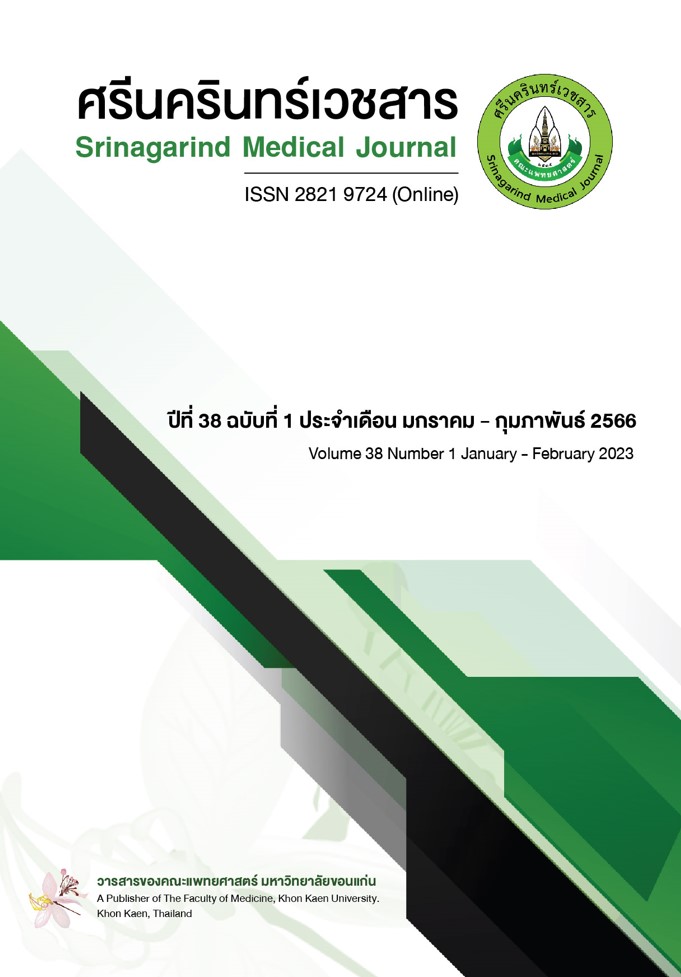Impact of COVID-19 Pandemic on Blood Donation in Blood Transfusion Center, Faculty of Medicine, Khon Kaen University
Keywords:
COVID-19 pandemic, blood donations, voluntary non-remunerated donations, replacement donationsAbstract
Background and Objective: Blood is important for saving lives. All blood used for medical treatments and surgery for patients were obtained from donations. The COVID-19 pandemic has severely impacted the lives of blood donors and people. People fear infection must strictly comply with public health measures and refrain from traveling causing the amount of blood donation to be reduced not adequate blood. There was a blood shortage crisis across the country. Therefore, the researchers wanted to study the impact of blood donations and the approach to blood supply during the COVID-19 pandemic on 2020-2021.
Methods: This studied was retrospective of blood donations for the year 2019-2021. The statistic used for data analysis was descriptive and the chi-square test.
Results: On 2019-2021 there were 29,861, 29,862 and 28,855 units of blood donated, respectively, donated blood on site were 20,206, 18,728 and 18,782 units (67.67%, 62.72%, and 65.09%), respectively. Donated blood on mobile units were 9,655, 11,134 and 10,073 units (32.33%, 37.28% and 34.91%), respectively. Donated blood on large mobile units (100-300 units at a time) were 61, 67 and 66 times (100.00%, 77.91% and 55.00%) respectively. Donated blood on small mobile units (20-50 units at a time) were 0, 19 and 54 times (0, 22.09% and 45.00%) respectively. There were non- remunerated donations types: 27,567, 27,420 and 23,484 units (99.66%, 98.96% and 86.46%), respectively, and replacement donations were 95, 289 and 3,678 units (0.34%, 1.04% and 13.54 %), respectively. When comparing the proportion of donated blood on site with mobile unit, large and small mobile units and the types of donations between 2019-2021, it was found that each year was statistically different (p-value < 0.001).
Conclusions: The COVID-19 pandemic on 2020 and 2021 caused a critical shortage of blood supply. Blood donation units had to adjusted their blood donations patterns. And adjusted operations in accordance with public health measures in order to have adequate and safe blood for both the blood donors and the recipient.
References
Leung JNS, Lee CK. Impact of the COVID-19 – a regional blood centre's perspective. ISBT Science Series 2020;15(4):362-4. https://doi.org/10.1111/voxs.12558.
World Health Organization (WHO). WHO statement regarding cluster of pneumonia cases in Wuhan, China. Beijing: WHO; 9 Jan 2020. [Internet]. 2020 [cited Oct 2, 2022]. Available from: https://www.who.int/china/news/detail/09-01-2020-who-statement-regarding-cluster-of-pneumonia-cases-in-wuhan-china.
World Health Organization. Interim guidance on COVID-19. [cited Oct 2, 2022]. Available from: https://www.who.int/publications-detail/maintaining-a-safe-and-adequate-blood-supply-during-the-pandemic-outbreak-of-coronavirus-disease-(covid-19).
Royal Thai Government Gazette. Communicable diseases act, B.E.2015 [Internet]. 2020 [cited Oct 2, 2022]. Available from: https://ddc.moph.go.th/uploads/ckeditor/c74d97b01eae257e44aa9d5bade97baf/files/001_1gcd.pdf.
Royal Thai Government Gazette. Emergency decree on public administration in emergency situation, B.E. 2005 [Internet]. 2020 [cited Oct 2, 2022]. Available from: https://giventake/content_give/em160748.pdf.
Royal Thai Government Gazette. Regulation Issued under Section 9 of the Emergency Decree on Public Administration in Emergency Situations B.E. 2548 (2005). [Internet]. 2020 [cited Oct 2, 2022]. Available from: https://www.tosh.or.th/covid-19/images/file/2020/T_0001. PDF? t= 1588827974.
Department of Disease Control, Ministry of Public Health. Information for self-protection from COVID-19 [Internet]. 2020 [cited Oct 2, 2022]. Available from: https://ddc.moph.go.th/viralpneumonia/file/introduction/ introduction01.pdf
Romphruk A, Butryojantho C, Jirasakonpat B, Srichai S, Simtong P, Sripara P,et al. Efficiency of blood inventory in blood transfusion center for Srinagarind hospital and Queen Sirikit Heart Center of the Northeast : 5 years experience (2013-2017). Srinagarind Med J 2019;34(1):99-106
Ratchak P. Editorial. Impact of COVID-19 in blood transfusion service of the 6 Andaman provinces. J Hematol Transfus Med 2021;31(4):377-83.
World Health Organization and International Federation of Red Cross and Red Crescent Societies. Towards 100% voluntary blood donation. A global framework for action. Geneva, Switzerland: WHO; 2010. [Internet]. 2010 [cited Oct 2, 2022]. Available from: www.who.int/bloodsafety/publications/9789241599696_eng.pdf.
Urwijitaroon Y. Safe efficient sustainable blood procurement and management in blood banks. J Hematol Transfus Med 2021;31:303-6.
Thai Red Cross Society. Impact of COVID-19 pandemic on blood donation [Internet]. 2021 [cited Oct 2,2022]. Available from: https://english.redcross.or.th/
Wang Y, Han W, Pan L, Wang C, Liu Y, Hu W, et al. Impact of COVID-19 on blood centres in Zhejinag province Chaina [Internet]. 2020 [cited Oct 2, 2022]. Available from: https://doi.org/10.1111/vox.12931.
Hakami N, Sulami A, Alhazmi W, Qadah T, Bawazir W, Abdullah Y, et al. Impact of COVID-19 on blood donation and supply: a multicenter cross-sectional study from Saudi Arabia [Internet]. 2022 [cited Oct 2, 2022]. Available from: https://doi.org/10.1155/2022/1474426.
Yahia AIO. Management of blood supply and demand during the COVID-19 pandemic in King Abdullah Hospital, Bisha, Saudi Arabia. Transfus Apher Sci 2020;59(5):102836.
Lertpaisankul S, Phomsila R, Thipsuwankul W, Phetsree N, Rodwihok T, Tadsomboon S. Model of blood recruitment and impact of blood management of the six lower-northern provinces during the COVID-19 pandemic in 2020. J Hematol Transfus Med 2021;31(1):35-45.
Jenwitheesuk S, Jenwitheesuk S, Chaijundee P, Punjaruk W, Sripara P. Attitudes and perceptions of future blood donors during Covid-19 Pandemic. Srinagarind Med J 2022;37(2):162-6
World Health Organization. Guidance on maintaining a safe and adequate blood supply during the coronavirus disease 2019 (COVID-19) pandemic and on the collection of COVID-19 convalescent plasma [Internet]. 2020 [cited Oct 2, 2022]. Available from: https://apps.who.int/iris/handle/10665/3318.
Kupatawintu P. Editorial. COVID-19 outbreak with the blood service of the country. J Hematol Transfus Med 2022;32(1):3-5.
Downloads
Published
How to Cite
Issue
Section
License
Copyright (c) 2023 Srinagarind Medical Journal

This work is licensed under a Creative Commons Attribution-NonCommercial-NoDerivatives 4.0 International License.




